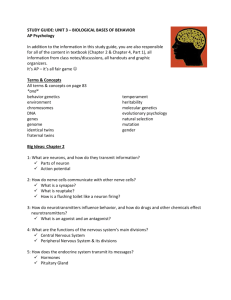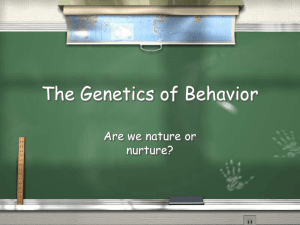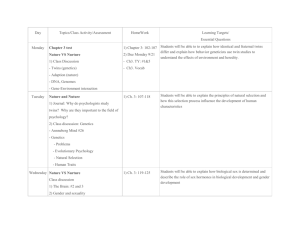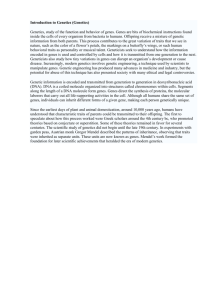Chapter 3 Notes Part 1
advertisement
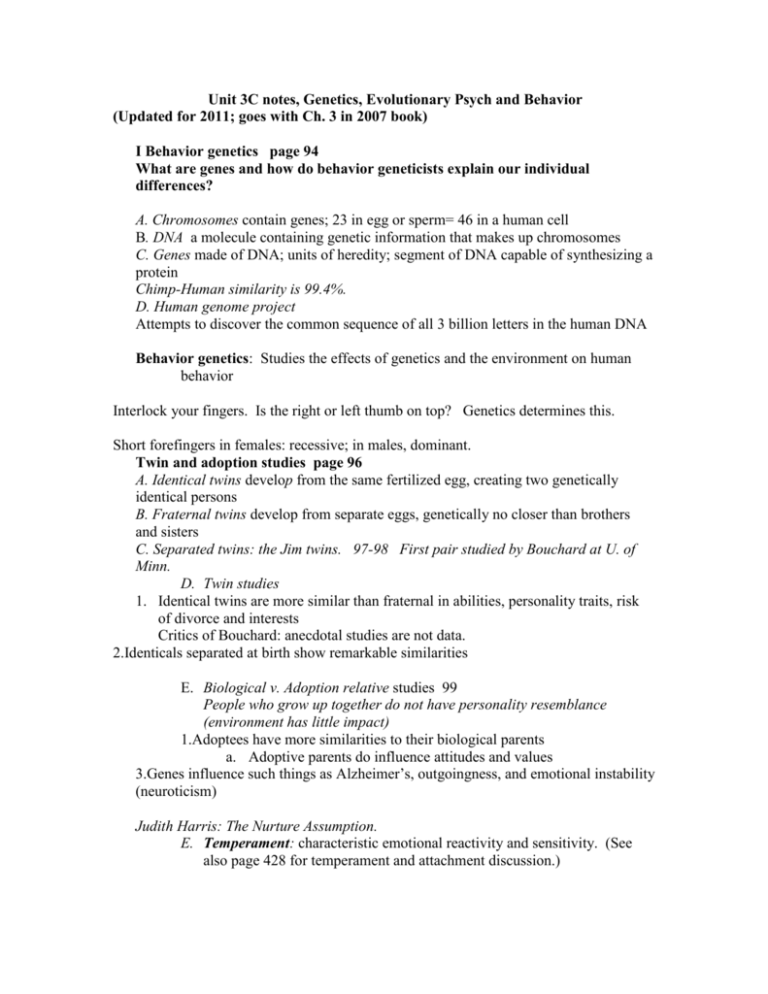
Unit 3C notes, Genetics, Evolutionary Psych and Behavior (Updated for 2011; goes with Ch. 3 in 2007 book) I Behavior genetics page 94 What are genes and how do behavior geneticists explain our individual differences? A. Chromosomes contain genes; 23 in egg or sperm= 46 in a human cell B. DNA a molecule containing genetic information that makes up chromosomes C. Genes made of DNA; units of heredity; segment of DNA capable of synthesizing a protein Chimp-Human similarity is 99.4%. D. Human genome project Attempts to discover the common sequence of all 3 billion letters in the human DNA Behavior genetics: Studies the effects of genetics and the environment on human behavior Interlock your fingers. Is the right or left thumb on top? Genetics determines this. Short forefingers in females: recessive; in males, dominant. Twin and adoption studies page 96 A. Identical twins develop from the same fertilized egg, creating two genetically identical persons B. Fraternal twins develop from separate eggs, genetically no closer than brothers and sisters C. Separated twins: the Jim twins. 97-98 First pair studied by Bouchard at U. of Minn. D. Twin studies 1. Identical twins are more similar than fraternal in abilities, personality traits, risk of divorce and interests Critics of Bouchard: anecdotal studies are not data. 2.Identicals separated at birth show remarkable similarities E. Biological v. Adoption relative studies 99 People who grow up together do not have personality resemblance (environment has little impact) 1.Adoptees have more similarities to their biological parents a. Adoptive parents do influence attitudes and values 3.Genes influence such things as Alzheimer’s, outgoingness, and emotional instability (neuroticism) Judith Harris: The Nurture Assumption. E. Temperament: characteristic emotional reactivity and sensitivity. (See also page 428 for temperament and attachment discussion.) 1. Some babies are born relaxed/cheerful, while others born tense/irritable 2. Identical twins will have more similar temperaments than non-identical What is heritability and how does it relate to individuals and groups? F. Heritability indicates what percent of traits are due to genetics If heritability of intelligence (or height, eye color, etc.) is 40%, that means that 40% of people will have inherited intelligence; 40% of the observed difference can be attributed to genes The father of behaviorism, John Watson (see pp. 6-7, 223-7) believed environment was the single greatest determinant of behavior and thinking. Group differences are not necessarily explained by genetics. Social environment matters. Nature and Nurture, page 101 It’s not nature v. nurture; it’s nature via nurture Genes predispose people toward depression and other psychological disorders. Genes are self-regulating: environmental circumstances can express some genes that are not expressed in other environments. Breast feeding can increase intelligence if a certain gene is present. G. Gene-environment interaction, 101 We are products of gene predispositions and the environment Interactions are the effect of one factor depending on another factor People who are judged as more attractive are more likely to get a job or a promotion illustrating the influence of genes on the environment H. Molecular Genetics 102 What is the promise of molecular genetics research? Studies molecular structure and the function of genes “bottom up” research: what specific genes influence a behavior? The micro level of understanding (similar to Unit 5 and sensation/perception) What mechanisms control gene expression? II. Evolutionary Psychology page 103 How do evolutionary psychologists use natural selection to explain behavior tendencies? Studies the effects of evolution on the behavior of humans Ordinary offspring compete for survival Biological and behavioral variations increase an organism’s reproductive and survival chances in their particular environment Offspring that survive are more likely to have children and pass on their genes This can lead to a change in population characteristics A. Natural Selection and Adaptation If you engage in behaviors that enable you to survive and reproduce, those behaviors have been naturally selected for They have been genetically predisposed An adaptation example is like breeding foxes to behave like dogs B. Mutations 104 Random errors in gene replication that lead to change in nucleotide sequences The source of all genetic diversity Evolutionary success helps explain similarities Shared human traits were shaped by natural selection Behavior tendencies, thinking and learning that contributed to success helped to shape the human genome Outdated tendency: our eating habits are a better fit for prehistoric times Evolutionary Psych Today, 105 Not about how one species evolved into another. About how genetics and environment interact leading to a change in genetics that fits the environment. Traits that lead to survival are more likely to be passed on. An Evolutionary Explanation of Human Sexuality How might an evolutionary psychology explain gender differences in sexuality and mating preferences? C. Gender differences and sexuality 105 1 women more likely to disapprove of/engage in casual sex 2. men more likely to initiate sex 3. men more likely to perceive warm responses as sexual advances 4. men prefer features suggesting youth and health 5. women prefer mates with resources and social status D. Natural selection and mating preferences, 106 Youthful appearance is more attractive for men across cultures Women attracted to mature, dominant, bold, affluent men F. compared with eggs, sperm are inexpensive G. women must care for an infant while the man can spread his genes around The evolutionary principle: nature selects behaviors that increase the likelihood of passing on one’s genes. E. Criticisms of the evolutionary perspective 107 What are the key criticisms of evolutionary psychology? H. they make too many hindsight explanations They don’t account for cultural facts that shape our behavior: what is attractive now wasn’t in the 1950s. Social and cultural factors shape gender differences in mate selection Reflections on nature and nurture, page 108 1. we are the product of nature and nurture The bio-psycho-social model see page 109, figure 3C.4 2.Roger Sperry views the brain and mind as a holistic system: the brain creates and controls the emergent mind, which in turn influences the brain; see 110, fig. 3C.5 KEY TERMS, PAGE 111
